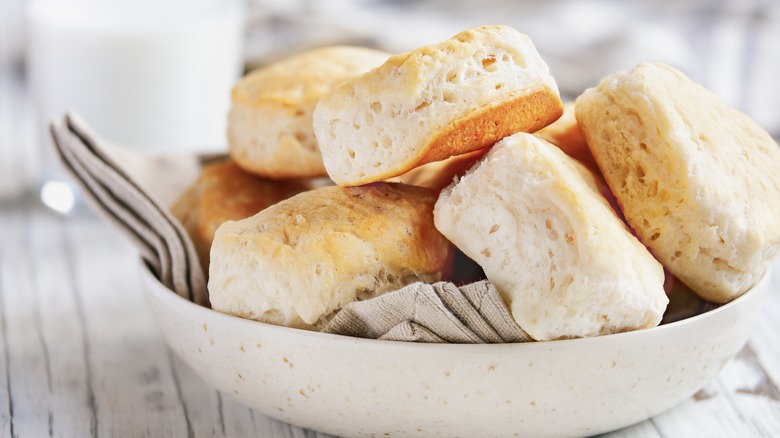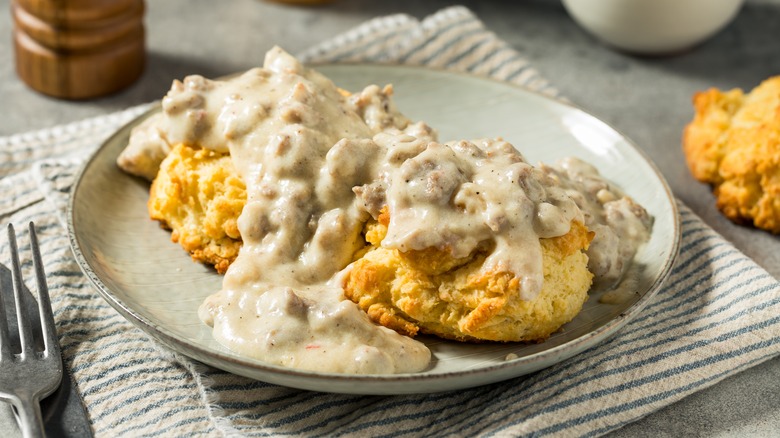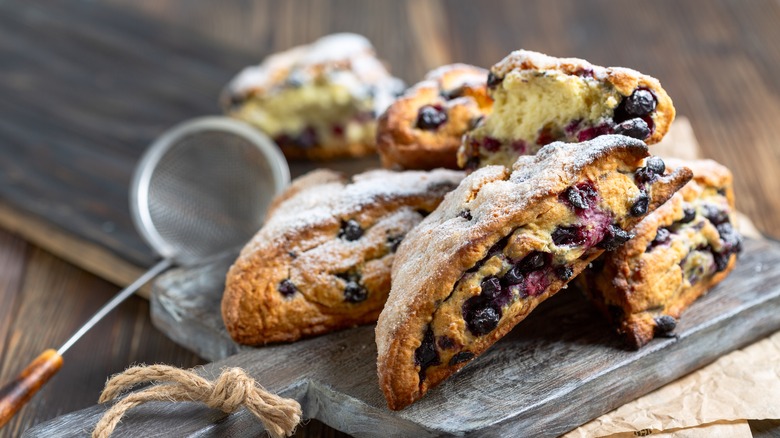The Exact Difference Between Biscuits And Scones
Warm, flakey, and delicious slathered in butter and jam — is this a description of a biscuit or a scone? If you're not sure, don't worry. Biscuits and scones are notoriously similar, with some even claiming there's actually no difference. They even share ancestry, having been derived from the same pastry recipe brought to the United States by British colonists. Different regions adapted the recipe into what eventually became today's American scones in the Northeast and biscuits in the South.
Examining these two pastries side-by-side, it's easy to tell they're cousins. Both are lightly crunchy and golden on the outside and softer on the inside because they're made from similar ingredients. Both recipes use flour, fat, and liquid to achieve their inviting textures and toasty, fresh-baked flavor. However, anyone claiming biscuits and scones are exactly the same would not only arouse the ire of certain regional groups, but would also be incorrect.
Despite their wealth of similarities, biscuits and scones have key differences that make them distinct from one another. Though their basic ingredient profiles are the same, each pastry calls for a different ratio of liquid, fat, and flour. Further, the types of liquid and fat used in biscuits are different from those traditionally used in scones. Plenty of people also insist that these two pastries serve different culinary purposes, and can't be used as stand-ins for one another.
What exactly are biscuits?
Ask anyone in the Southern United States what makes a good biscuit, you'll likely get descriptors like "light and flakey" and "plenty of tender layers." Biscuits also tend to have a rich, buttery flavor that plays against their light and airy texture. Some recipes also call for a touch of sugar, which only enhances their salty, buttery goodness.
A traditional biscuit's iconic texture is the result of a carefully balanced ratio of wet, dry, and creamy ingredients. When the original British pastry recipe made its way to areas like Appalachia and the Southern States, home cooks swapped out some of the ingredients for things that were more readily available. For instance, heavy cream was replaced with buttermilk, and plenty of butter or lard made up for a lack of eggs. This combination yielded a pastry that was fluffy, flaky, and delicious enough that it's been a staple of Southern cuisine ever since.
Unlike scones, biscuits are hardly ever eaten by themselves. Instead, they're usually smothered in classic sausage cream gravy for a hearty breakfast or comforting dinner. This might also be served with sunny-side up eggs, with the yolks adding richness to the gravy as they sink into the fluffy biscuits. Of course, the best way to round out this meal is with one or two more biscuits slathered in butter and jam or honey, and washed down with hot coffee or — for a more modern crowd — a savory, caffeine-free cup of chaga.
What exactly are scones?
A scone just isn't a scone without a dense, crumbly interior surrounded by crunchy, sugar-dusted crust. Certainly, the British version is less sweet and a little fluffier than the U.S. variety, but we're tackling American pastries here. Their tight, moist crumb pairs exceptionally well with tart fruits like currants and dried apricots, but many also enjoy them plain with clotted cream and marmalade or fruit preserves.
Just as cooks in the Southern states adapted biscuits' ancestor pastry to suit their needs, so did individuals in the Northeastern region. Bakers in this area had ready access to heavy cream and plenty of eggs, which led to a recipe with more liquid and less fat than the Southern biscuit. In fact, some scone recipes don't use butter at all, instead relying on the cream and eggs to provide the right amount of fat.
Though biscuits may sometimes be sweet, you'll be hard-pressed to find a scone smothered in sausage gravy. You're much more likely to find a triple-berry scone coated in sugary glaze, a lemon poppy seed variety, or a chocolate version studded with dried cherries. However, some bakers have happily embraced savory scones by stirring things like sharp cheddar, bacon, and chives right into the batter. The best part is that any of these flavors can still be sliced open and enjoyed with butter for the ultimate indulgent brunch experience.


